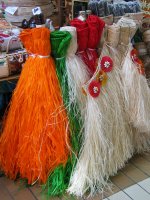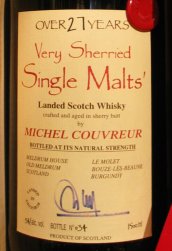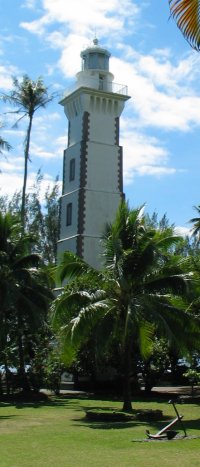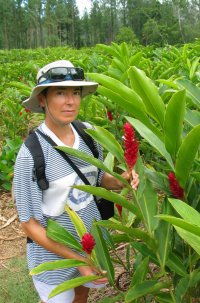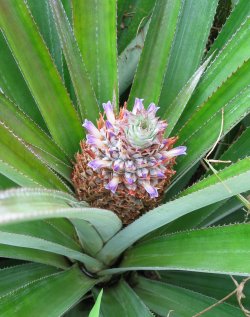 Society
Islands- August 2005
Society
Islands- August 2005
|
The Society Islands are a small group of islands around Tahiti. We visited four of them: Tahiti, Moorea, Huahine and Bora Bora. |
|
The trip from Ahe in the Tuamotus to Tahiti took only three days with light winds and easy sailing. The only excitement was during the night before we arrived when Tom was woken by a loud thump and Sue shrieking. We are used to flying fish landing on deck but this one was bigger than most - a one metre-long barracuda had jumped out of a relatively calm sea and hit our mizzen mast about 3m above sea level before falling onto the back deck. Unfortunately he was beyond saving and no good for eating (ciguaterra, a toxin that accumulates in tropical fish, is especially high in predatory fish close to coral reefs). Glad he didn't hit one of us ... or bite us - look at those teeth! |
The biggest flying fish in the world! |
|
|
|
|
Although part of every cruising sailor's dreams, there is no doubt that Tahiti is not what it once was. In fact Captain Cook said much the same thing on one of his later visits! It is no longer the unspoilt South Seas paradise of popular imagination.
|
|
Nechtan on the quay at Papeete in Tahiti.
|
|
The main town, Papeete, resembles the south of France more than anywhere else in Polynesia and the island abounds with fancy resort hotels. But who's complaining? - it was so bad we only stayed for two weeks! It was a nice change to have bars, restaurants and shops just a few steps away. |
|
Papeete has a market where we were able to buy fruit and vegetables ... and grass skirts and matching coconut bras (if we wanted!). We were surprised by the huge quantities of shell products available for sale - conservation groups always request that you do not purchase items made from endangered/protected species (e.g. turtles) or collect shells, etc, yet every market we have wandered through has trillions of such items for sale. |
|
Spot the stallholder! |
Hundreds of tiny shells make up each necklace.
|
|
Amongst colourful pareus and baskets, Tom managed to find the beer mugs!
|
Grass skirt, anybody? |
|
In a specialist wine shop we discovered a whisky, which we have never heard of, made at Meldrum House in Oldmeldrum, only about 15 miles from our house in Scotland. It cost 118280 francs, or roughly US$118 or £62.
|
|
|
The town hall in Papeete.
|
|
|
One night we went to a show of traditional dancing at the nearby small town of Arue. It was a free show organised by and for the local community and featured several dance troupes and bands, including the overall dance champions of the annual French Polynesian Fete competitions. |
|
|
|
|
|
|
|
Sue especially appreciated the fact that the bands are mostly just drums. It was a fun night out and a spectacular show.
|
|
|
|
On 8 August, the ocean racing trimaran Geronimo arrived. This was to inaugurate an annual yacht race from Sydney to Tahiti. All the yachts in harbour dressed overall (i.e. put all our flags up) and they were welcomed with hooters, a flotilla of canoes, bands and dancers. |
|
Geronimo arrives... |
... to be greeted Polynesian style. |
|
Sunset over Moorea from Tahiti. |
|
However, after a few days the noise and bustle of town got too much, so we went out to anchor just 5 miles away in the shelter of the fringing reef. We spent about a week here, snorkelling, socialising, having a barbie and enjoying the stunning sunsets over Moorea. |
|
Rare, medium or well done?...
|
|
...do you mean the meat or the attendees? |
|
Wherever we go, folks are interested in Tom's bagpipes. Thomas (below left) and Wolfgang, sailing with Jolly Celeste, both were successful in getting sounds out! |
|
|
|
|
|
Coral and reef fish. |
Long-nosed Butterflyfish. |
|
Puffer fish. |
Damselfish and a single wee yellow fish with a blue eye, hiding in the coral. |
|
We returned to the town quay for another few days, to get our fill of big city life. During this time we visited Point Venus on the northern tip of Tahiti. This was where Captain Cook set up camp to measure the transit of Venus on 3 June 1769. In 1788 Captain Bligh of the Bounty also camped here for two months, collecting breadfruit shoots for transportation to the West Indies. The biggest surprise for us was the lighthouse there - it was designed by Robert Louis Stevenson's father, Thomas Stevenson, one of the great family of engineers who built many of Scotland's lighthouses. |
The Stevenson Lighthouse (built 1867) at Point Venus, Tahiti. |
|
While provisioning in Papeete we found the above in the supermarket - a tartan bag with a very loyal-looking Scotsman on, containing Old England Toffee made in Chile. At the bottom of the packet it says "El auténtico [authentic] Toffee"! |
Not to be missed in Papeete are the roulottes on the pier - fast food caravans serving anything from pizza to chinese to fish to icecream and pancakes. The "fast" part of the food is that the folk who do the cooking move like blurs and are shrouded in cooking steam! Excellent food, great ambiance and good price. Tucking into delicious Chinese food. |
|
Opunohu Bay, Moorea. |
|
On 21 August, we left Tahiti and sailed over to the quieter island of Moorea, about 20 miles away. We anchored in Opunohu Bay which was used in the filming of South Pacific and Mutiny on the Bounty. |
|
|
Moorea. |
|
|
It was around Moorea that we saw our first large whales. Humpbacks come here from Antarctica for a few months each year to give birth. We saw several whales in and around Opunohu bay, though sadly none was close enough to us for a good photograph. We also did some more snorkelling - there is always something new to see under water. |
|
A big moray eel. |
A Picasso thingamybob. |
|
Wee yellow fish. |
Big pink fish. |
|
We also walked up the hill at the head of the bay where we saw a few ancient marae (stone platforms used for religious ceremonies). From up the hill there was a good view of Opunohu Bay and the neighbouring Cook's Bay (Captain Cook visited but did not stay there).
|
The Afareaitu marae dates back to 900AD. |
|
|
Opunohu Bay on the left and Cook's Bay on the right. |
|
|
Red ginger is used extensively in flower arrangements. |
|
We also walked around the agricultural college gardens and learned a lot about the locally produced fruit and flowers. Much of the produce is sold to local restaurants and used in floral decorations. |
|
A field of pineapples at the agricultural school. Great backdrop! |
|
A young pineapple with some purple flowers on top. |
|
|
An interesting mural on the wall of a building in Papetoai, Moorea. |
|
|
The octagonal Protestant church, Papetoai, Moorea. |
|
The octagonal Protestant church in Papetoai was built on the site of the temple of the god Oro in 1822. Despite having been rebuilt several times, the church is known as "the oldest European building still in use in the South Pacific". It also appears in the mural above. |
|
The sail to Huahine was rough going, overnight with gale force winds and swells from 2 directions. Things were jumping around so much that we broke our first bits of crockery since leaving Scotland (two mugs took off and went flying). However, the passage made us appreciate the tranquility of Huahine all the more. We got our folding bikes out and visited more historic sites. The roads were almost deserted and nice and flat (just as well as we only have one gear on our bikes!).
|
|
Cycling on Huahine. |
A long deserted beach on Huahine's north coast. |
|
Above: Sue reads the plaque on the grave of French marines sent to annex the island in 1846, but defeated by the islanders. Right: Unu, or large wooden stele, are probably totems for the guardian spirits of a family or tribe in their incarnations as fish, birds, dogs, sharks, etc. Marae Rauhuru, Huahine. |
|
|
Huahine was probably our favourite of the Society Islands, because it was quieter and seemed to be less oriented towards tourism and hence more "real". |
Sunset over the island of Taha'a viewed from Huahine. |
|
Three local lads on Huahine. |
|
With fewer tourists, the locals tend to be friendlier. These three boys questioned us at length on what snow was like. Sue, being a Western Australian, could appreciate their fascination, never having seen snow falling until in her mid-twenties. |
|
Next stop was Bora Bora, heralded as "The Pearl of the Pacific" and "The most spectacular island in the Pacific". It was nice enough, but was just too much of a resort island for us.
|
|
|
Boat storage Bora Bora-style - guess it saves on antifouling paint.
|
|
|
Bora Bora Yacht Club - the cruisers' watering hole. |
|
The highlight of our stay was provided by the Bora Bora Yacht Club where we enjoyed a superb meal at their restaurant. They also have showers and a laundry for the use of yachties. We anchored for a few days in a quiet spot away from the jet skis and souvenir shops, filled up with water, diesel and food and then headed off for Rarotonga in the Cook Islands, about 500 miles away. |
